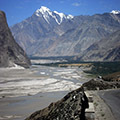 Home to more life, culture, beauty and biodiversity than you can even begin to imagine, the HKH is a microcosm of the world around us and the source of clean drinking water for close to two billion people. It is the place where, quite literally, the earth comes together, and its reach spans across everything. Regions. Countries. Landscapes. Languages. But despite its global importance, the HKH remains one of the poorest and most neglected regions in the world. The forces of climate change and globalization are wreaking havoc on this fragile asset, wiping out resources, communities and cultures that have existed for centuries. Being at the top of the world, changes happen here before they happen anywhere else and the beat of this place vibrates across the globe.
Home to more life, culture, beauty and biodiversity than you can even begin to imagine, the HKH is a microcosm of the world around us and the source of clean drinking water for close to two billion people. It is the place where, quite literally, the earth comes together, and its reach spans across everything. Regions. Countries. Landscapes. Languages. But despite its global importance, the HKH remains one of the poorest and most neglected regions in the world. The forces of climate change and globalization are wreaking havoc on this fragile asset, wiping out resources, communities and cultures that have existed for centuries. Being at the top of the world, changes happen here before they happen anywhere else and the beat of this place vibrates across the globe.
The HKH region extends 3,500 km over all or part of eight countries from Afghanistan in the west to Myanmar in the east. It is the source of ten large Asian river systems – the Amu Darya, Indus, Ganges, Brahmaputra (Yarlungtsanpo), Irrawaddy, Salween (Nu), Mekong (Lancang), Yangtse (Jinsha), Yellow River (Huanghe), and Tarim (Dayan) – and provides water, ecosystem services, and the basis for livelihoods to a population of around 240 million people in the region. The basins of these rivers provide water to 1.9 billion people, a fourth of the world’s population.
A considerable volume of water resources is stored as snow and glacier ice in the HKH. Cryosphere components including permafrost and glacial lakes provide various ecosystem services for mountain and downstream communities. The snow cover area during winter varies between 951,000 sq km and 1,390,000 sq km. During summer, it ranges between 388,000 and 481,000 sq km The total glacier area can extend up to 87,340 sq km.


